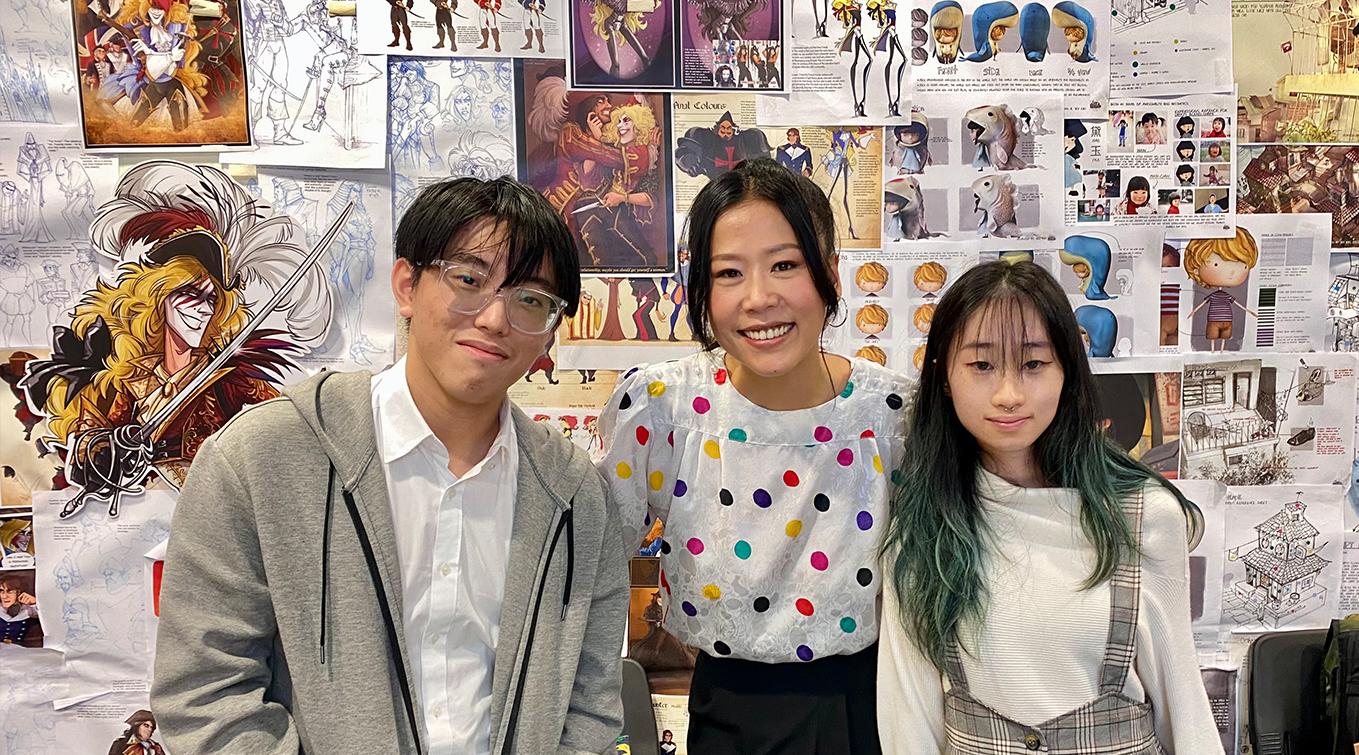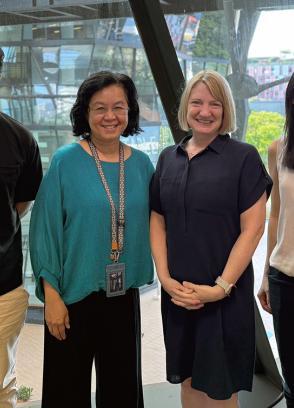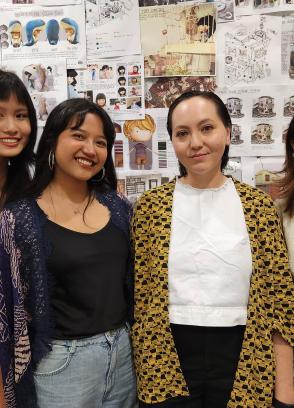(From left: Kenton Lam, Domee Shi and Delcie Chen)
Written by BA(Hons) Animation Art level 2 students Kenton Lam and Delcie Chen.
As the animation industry reaches the pinnacle of its quest for photorealism, a new generation of creative minds is stepping up to usher in an era of both stylistic and narrative diversity. One of the trailblazers spearheading this cinematic turning point is Domee Shi, Vice-President of Creative at Pixar Animation Studios.
Despite gaining international acclaim with her Academy Award-winning short film Bao and her directorial debut, Turning Red, the down-to-earth Sheridan College graduate could not have come from more humble beginnings. Her passion and infectious enthusiasm has fuelled her growth from intern, to story artist, to film director and now, a key creative decision maker in Pixar. Domee also devotes herself to mentoring and guiding budding artists, and was recently in Singapore for Animation Nation 2022.
After a well-received masterclass at LASALLE to a full house of animation enthusiasts, we sat down with Domee for a chat where she shared how she has evolved as an artist since leaving school, and offered advice for students looking to enter the industry.
Hi Domee, welcome to LASALLE and thank you for the great masterclass!
To kick off the interview, we thought we’d go back to your student days to start. Your final year short film at Sheridan, Well-Being, and your first Pixar short Bao are vastly different in style and storytelling. Could you tell us a bit about how you’ve grown as a filmmaker?
Now, there’s an amazing wave of people embracing their backgrounds and where they come from. We're realising that there is value and importance in tapping into your own past."
As a student, my style was constantly evolving and changing! I drew very differently in my first year than I did in my fourth year. At that point I was very excited by all the European artists I was finding online, and inspired by French illustrators and French animation. I was very influenced by them for the look of Well-Being.
Throughout my time in school, professors would encourage us to explore different styles, and I appreciated that because it forced me to widen my horizons. But I think it also made me stay away from anime—it was kind of taboo then. I re-discovered my love for it only after graduating.
For Well-Being, I just wanted to make something that was fun and surprising, and I was really drawn to the character dynamic of this bratty little girl and her older brother who she bosses around. She did remind me of myself at that age, though it wasn't really supposed to feel like a personal story. I don't think I knew about, or was encouraged to tap into my own experience or my own history or my story at school, especially at that time.
Now, there’s an amazing wave of people embracing their backgrounds and where they come from. We're realising that there is value and importance in tapping into your own past.
Yes, animation has seen a lot of changes in styles and narratives. Turning Red is part of a wave of recent works that adopt hyper-stylised modes of animation, and the narratives in animated films have also become increasingly personal, rooted in specific contexts and cultures. How do you see the industry evolving as it embraces these creative shifts in narratives and visual style?
I think computer animation has mastered photorealism and at this point it's hard to tell the difference. That just pushes a lot of creative people to think about what's next, and how to push the boundaries of animation in different ways that we haven't seen before.
I think that's why we are seeing more stylised animation projects coming out, and studios are realising that audiences have more of an understanding of and appetite for different styles of animation.
Ultimately, it still comes back to the emotional heart of the story. For Turning Red, we approached Pete Docter with the idea for the look of the movie. We told him we wanted to push the colours, the style, bring in anime influences. He said, “Okay, I’m open to it but it has to come from a place of the character’s emotion. It has to serve a purpose.” He challenged us to think about the reasons why we are doing this, why we choose this colour or this shape.
That helped us focus our thoughts and experiments—like it wasn’t just we’re going to stylise the movie, let’s use every colour and make everything super wacky! We still have to feel emotional when we see Mei and her mom interacting on screen.
You were active on Tumblr and Blogspot as Doremimi, posting sketches and mini gifs about things that interest you like magical girls and food. What do you think is the value for animators and artists to put themselves out on the internet, and what tips do you have about managing your social media presence?
Yeah, it's huge now. These days we've been finding artists through their Instagram, and hiring them on a freelance or contract basis from the work that they show, so I think having an online presence does help. You don't have to be an influencer, but any way that you can get your work out there and share with the world your voice and who you are, I think that's important.
But then, you know there's the double-edged sword of that too. I felt it a little bit when I was in college. I had a DeviantArt profile, and at some point I found myself chasing the likes and the comments, the favourites and the views. That's not good either. That's just as bad as comparing yourself to your peers and chasing grades and accolades.
So I think having an online presence is good, but don't let it affect you in too much of a negative way. It's just another platform. Don't attach too much importance to it.
You’ve recently stepped into a larger leadership role as Vice President of Creative in Pixar, and you’ve described your experience with it as trying to be more helpful outside of the movie you are working on. How was the transitional process from an animator and story artist to a director, and now to a mentor and producer's role?
I think with each step I just had to become more of a social person! I had to rely on my communication skills more and more with each transition, which was hard for me, being this shy artist who preferred to let her drawings speak for themselves.
But I found this new joy and excitement with every new transition, from story artist to director. I discovered the awesome feeling of collaboration, of working with other super-talented people who can help your project go where you could never take it before on your own. That was so satisfying and so exhilarating.
Now with the move from being a director to Vice President of Creative, again, it's that satisfaction and feeling of helping another filmmaker go through the process of directing a film at Pixar, giving them advice on problems that I dealt with myself. Seeing them thrive, I feel like a proud parent.
As a mentor, what advice would you have for students trying to navigate this difference in approach as they transition from university into the industry?
I would say for me, what helped me the most through my career and through the transition was finding peers and friends.
Often you can feel so alone in your journey, so it's everything to have that community and that support system of artists and friends who are in the industry with you, and you're all struggling together. That's everything. They can also give you real feedback, like they won't hold back and you know that they have your best interests at heart and you can grow and be challenged with this group of people.
That's the most important thing: to find your community, on top of practice and honing your skills, working on that portfolio and trying to find your unique voice as a filmmaker.




